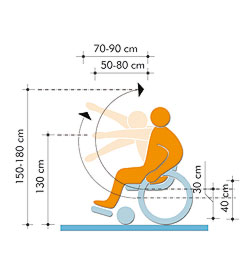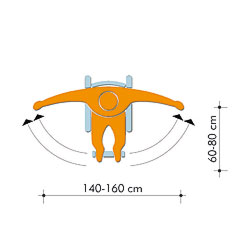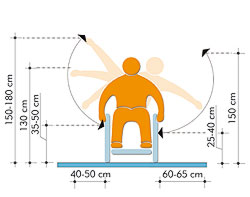Working on a wheelchair
According to Polish law, the urban public space, including company offices and factories, ought to be designed and maintained to be easily accessible to the disabled. The following text contains a list of accommodations necessary to create an accessible environment for people on wheelchairs.
The parameters that must be taken into account when designing an accessible working environment for an employee using a wheelchair are: SPACE for a wheelchair to manoeuvre (forward, back, to the sides, turning), WHEELCHAIR DIMENSIONS (width, height etc.), EYE HEIGHT and REACH of a person on a wheelchair. Note that the following data may differ depending on the wheelchair's type and on the degree of disability.
Vertical reach

Safe and convenient commute:
Driveway - hard and anti-slippery surface, for
dimensions see Building Regulations
Gate – minimum width – 2,4 meters, opening
inward.
Gateway – width: from 0,9 to 1,1 meters, opening
inward. Knobs and locks within reach of a person on a wheelchair.
Gate control panels and parking meters ought to be accessible
without getting out of a car.
Parking spaces – well-marked and placed near the
building entrance. Dimensions: length – min. 5 m, width – min. 3,6
m; if the parking spot is alongside a street, then length - min. 6
m and width - min. 3,6 m or 2,3 m if there is an adjoining
pavement. Surface: smooth and anti-slippery. Kerbs no higher than 2
cm.
Pavements and alleys leading to the building
entrance should also be smooth, even, anty-slippery and about 1,5 m
wide.
Ramps – made of wood, steel or concrete. Minimum
width: 1,2 m. If the ramp's length exceeds 9 m, it should be
divided into two or more ramps with an intermediate resting level
at least 1,5 m long between them. The railings ought to be
installed on both sides of the ramp at a height of 0,75 to 0,9 m,
oval, square or circle shaped for a good grip. A 5-7 cm high kerb
arranged all along the ramp will prevent the wheelchair from
sliding off it. The ramp should also be roofed (the roof ought to
be slightly longer and wider than the ramp), well-lit and have an
anti-slippery surface. Portable ramp (1,5 m wide) can be used if a
flight of steps consists of no more than 3 steps.
Entrance – 1 m wide (double door: 2 x 90 cm).
Threshold: max. 2 cm, otherwise (a) ramp is required. Glass door,
which can easily be damaged by the chair's wheels or other
protruding parts, ought to be equipped with 40 cm high protective
panels. Door bells, locks etc. situated at a height of 70 - 120 cm,
roofed, well-lit, easily accessible. Plus a wide handle above the
doorknob.
Horizontal and vertical reach


Accessible internal environment
Vestibule – minimal dimensions: 1,5 x 1,5 m; more
if the entry and vestibule doors open inward. Skirting board all
along the walls. Handholds allowing the disabled to get off the
wheelchair safely. Anti-slippery floor, coat-hangers at a maximum
height of 1,4 m.
Corridors – min. width: 1,2 m; wider if doors open
outwards. 90° corners must be rounded. Skirting boards to prevent
the wheelchair from hitting the wall. Light switches within reach
of a wheelchair person. Anti-slippery surface.
Doors – 1 m wide
Windows – 80 – 85 cm above the floor, locks and
handles at max. height of 1 m, opened manually or by remote
control. Windowsill slightly protruding from the wall.
Terrace – ramp if necessary
Lift – minimal dimensions: 1,4 x 1,1 m.
Control panel within wheelchair user's reach. Handholds 90 cm above
the floor. Emergency power system. Anti-slippery floor. There
should also be 1,5 m of free space in front of the lift door.
Lift platforms – vertical or inclined. Maximum
capacity: 300 kg; max. velocity: 0,2 m/s (vertical) and 0,15 m/s
(inclined). Non-slip platform, safety barrier and railing,
emergency brake, anti-slippery surface.
Toilet - free turning space with a diameter of 1,5
m. Handholds 75 - 80 cm above the floor. Toilet seat at a height of
0,5 m and equipped with collapsible arm rests on both sides. Flush
button height: 1 m. Paddling pool min. dimensions: 1 x 1 m.
Wash-basin: 80 cm (upper edge), 65 cm of free
space under the basin. Electrical sockets 40 - 120 cm from the
floor and at least 60 cm away from the taps. Anti-slippery
floor.
Based on: 'Dostosowanie budynków użyteczności publicznej – teoria i narzędzia' by Integracja
Artykuł powstał w ramach projektu "Integracja
- Praca. Wydawnicza kampania informacyjno-promocyjna"
współfinansowanego z Europejskiego Funduszu Społecznego w ramach
Sektorowego Programu Operacyjnego Rozwój Zasobów Ludzkich.
Komentarze
-
odpowiedz na komentarzluciamb60
03.04.2024, 15:23 -
odpowiedz na komentarzLavilldox
14.03.2024, 13:48 -
odpowiedz na komentarzkarlyr69
08.03.2024, 16:22 -
odpowiedz na komentarzLamaTrelf
23.02.2024, 05:53 -
odpowiedz na komentarzgaylemr2
13.02.2024, 07:22 -
odpowiedz na komentarzLavilldox
28.12.2023, 12:03 -
odpowiedz na komentarzLavilldox
04.09.2023, 12:40 -
odpowiedz na komentarzaaaalipaa
31.07.2023, 11:57 -
odpowiedz na komentarzCharleslow
26.07.2023, 11:47 -
odpowiedz na komentarznftopenseaapove
05.06.2023, 15:11 -
odpowiedz na komentarzJeffreyClurl
30.05.2023, 11:17 -
odpowiedz na komentarzLucilleFob
29.05.2023, 10:20 -
odpowiedz na komentarznftopenseaapove
22.05.2023, 11:22 -
odpowiedz na komentarzScottcip
11.04.2023, 15:23 -
odpowiedz na komentarzRoberttog
07.04.2023, 01:15 -
odpowiedz na komentarzlipovskialexx
06.04.2023, 10:21 -
odpowiedz na komentarzMartinBic
06.04.2023, 09:39 -
odpowiedz na komentarzbinanceapove
03.04.2023, 14:51 -
odpowiedz na komentarzDavidexips
29.03.2023, 12:26 -
odpowiedz na komentarzraritysniperapove
27.03.2023, 11:09 -
odpowiedz na komentarzGustavoChuri
24.03.2023, 14:37 -
odpowiedz na komentarzGeraldacedy
24.03.2023, 11:20 -
odpowiedz na komentarzWindow company vaw
16.03.2023, 11:52 -
odpowiedz na komentarzMichaelAmusa
16.03.2023, 09:10 -
odpowiedz na komentarzDannyhophy
14.03.2023, 09:59 -
odpowiedz na komentarzThomasSnobe
13.03.2023, 13:23 -
odpowiedz na komentarzVodapyday
08.03.2023, 13:05 -
odpowiedz na komentarzJamesAbire
07.03.2023, 18:21 -
odpowiedz na komentarzFordireGes
06.03.2023, 13:25 -
odpowiedz na komentarzJamesdap
16.02.2023, 10:20 -
odpowiedz na komentarzDavidThexy
15.02.2023, 11:13 -
odpowiedz na komentarzDonniebiarf
24.01.2023, 11:17 -
odpowiedz na komentarzPatrickpek
23.01.2023, 11:41 -
odpowiedz na komentarzKathrynnob
04.01.2023, 10:35 -
odpowiedz na komentarzRichardoneby
04.01.2023, 10:29 -
odpowiedz na komentarzMichaelTaite
02.01.2023, 15:24 -
odpowiedz na komentarzAlexanderamups
02.01.2023, 15:10 -
odpowiedz na komentarzWilliamboype
22.12.2022, 11:06 -
odpowiedz na komentarzhep
12.12.2022, 10:34 -
odpowiedz na komentarzJustincoefe
08.12.2022, 14:41 -
odpowiedz na komentarzDavidGon
29.11.2022, 09:43 -
odpowiedz na komentarzBrynnhoage
29.11.2022, 09:14 -
odpowiedz na komentarzEugeneDal
28.11.2022, 14:32 -
odpowiedz na komentarzChriscrymn
28.11.2022, 13:39 -
odpowiedz na komentarzCoutheMic
28.11.2022, 12:48 -
odpowiedz na komentarzUelinMic
28.11.2022, 12:25 -
odpowiedz na komentarzJudianMic
28.11.2022, 12:25 -
odpowiedz na komentarzMichaelImami
09.11.2022, 15:07 -
odpowiedz na komentarzKeganMn
02.11.2022, 09:17 -
odpowiedz na komentarzJamesjok
01.08.2022, 22:25
Polecamy
Co nowego
- Trenuj blind tenis: zajęcia z tenisa ziemnego dla osób niewidomych i słabowidzących
- Sytuacja FUS jest stabilna
- NIK: Potrzeby osób z niepełnosprawnościami są wciąż niedostrzegane
- PFRON: Wypożyczalnia technologii wspomagających dla osób z niepełnosprawnością
- Minister ds. polityki senioralnej: młodzież będzie uczyła osoby starsze korzystania z internetu




![kadr z filmu Mateusz Jarecki. Mądrość dziennikarza [FILMIK]](/files/nowe.niepelnosprawni.pl/public/2024/wideorozmowa_jarecki.jpg)
Dodaj komentarz